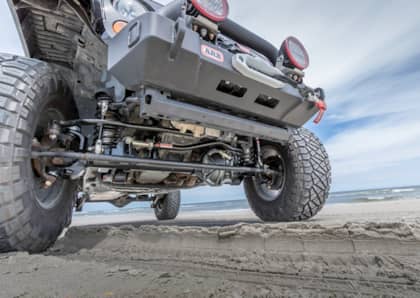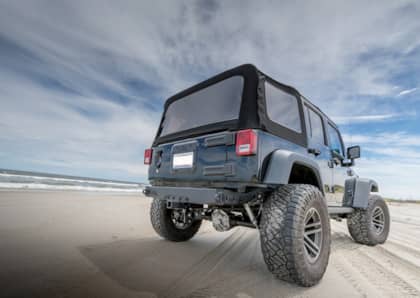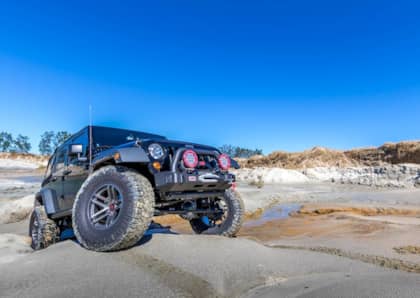JKS Flex Connect: Not Your Average Sway Bar Disconnect
Whether you're pushing it hard on the trail or just trying to keep all four planted on the daily commute, your Wrangler’s sway bars are key to maintaining the Jeep’s stability. When it comes to going off-road, the most common practice is to remove or disconnect the front sway bar as soon as the tires hit the dirt. Since most stock sway bars are engineered with an extremely aggressive rate to prevent body roll on the street, the bar won’t allow for increased articulation needed on the trail. The stiff rate can also cause a rough ride in the dirt.
While disconnecting the sway bar works fine for many trail scenarios, there are plenty of instances where keeping the sway bar attached actually has major benefits. Exploring beyond the blacktop isn’t always about achieving extreme articulation. In fact, many ‘wheelers enjoy long-distance trails that often have stretches where they can maintain near highway speeds. When you’re cruising at a more rapid pace off-road, keeping your sway bar attached is highly recommended for the same reasons you stay connected on the street. This is why you see so many Ultra4 Cars fit with custom sway bars.
For the 2007 to 2016 Jeep Wrangler, the factory-equipped sway bar is far too stiff to leave attached in stock form. Even those with Rubicon models such as ours will find that the electronic disconnect bar is speed limited to around 20 miles per hour. While there are a few ways to upgrade your JK’s sway bar to allow for additional “give,” the new Flex Connect Sway Bar Link Kit from JKS Manufacturing just might be the easiest.
To understand the how and why of the new sway bar upgrade, we picked up a set for our 2013 Jeep Wrangler Unlimited Rubicon.

JKS is known for its Quicker sway bar disconnects, and the JKS Flex Connect Sway Bar Link Kit builds on that same principle. The patent-pending Flex Connect end is fit with two small springs that sit inside of the sway bar cylinder. In the base kit shown below, the springs are 35 percent softer than stock. This equates to approximately 1.1 inches of movement at the link. The concept behind this allows you to be able to retain the handling benefits of the stock sway bar, while removing a lot of the harsh side-to-side transfer that can equate to a rougher ride on-road and off.

One of the aspects that drew us to the Flex Connect were the available spring rates. This is the Performance Spring Kit, which includes three additional rates along with the tools you need to easily dissemble the link. Built by PAC Racing Springs, an industry leader in coil spring technology, each coil pairing has a recommended use. The breakdown is as follows:
- Red: (Road) springs, 45-percent softer than stock, with 1.3 inches of link travel.
- Yellow: (Trail) springs, 60-percent softer than stock, 1.6 inches of link travel.
- Blue: (Crawl) springs, 75-percent softer than stock, 2.3 inches of link travel.

We were interested in testing out each spring set, so we quickly became accustomed to the removal and installation process. The custom wrenches provided make the process extremely easy. Since one spring simply sits in the cylinder, and the other is captured by a nut and plate, it only takes a few minutes to swap from one spring set to another. You’ll need to put a small dab of grease on the springs, but no additional items will be needed.

Since our JK was equipped with a 2.5-inch JSPEC Suspension System, we already had the disconnect posts in place. You also have the option of bolting the links in if you don’t plan on taking off the sway bar links on the trail.

To install the setup, measure both links to ensure they are the same length. Then you can slide on the standard link end on the passenger side of the Jeep.

Once you have the links in place, hit each grease fitting with a small amount of grease. Despite its larger size, the Flex Connect link doesn’t interfere with any of the JK's front end components.

How They Work
Undoubtedly, the biggest questions we have are: how does all of this work? and does it make a difference?
After cycling through all of the spring options, we found the Yellow (Trail) set to be our favorite by far. While 60-percent softer may sound like a lot, it only equates to the link traveling 1.6 inches. For us, this was the best balance of on-road control and off-road effectiveness with the sway bar connected. Long stretches of rough gravel and poorly maintained back roads are now significantly smoother. The jarring and head bobble generally experience in those same situations is gone.
If you are willing to sacrifice a little wheel travel, but even more off-road compliance, the Blue (Crawl) springs work great with the sway bar connected. However, they just didn’t give us the on-road feel we wanted. If we wanted that level of travel, we would simply disconnect the sway bar. As for the Red and Basic spring sets, they weren’t as noticeable on the street (which was a good thing if you are a canyon carver type driver). You could tell they softened up the bar rate on rough roads, but they just didn’t have as smooth of a feel as the Yellow spring set.
Ultimately, we like the Yellow spring set, but you might find another rate fits your driving style and Jeep better. While not the cheapest sway bar link set, the ride quality and handling benefits are well worth it.











